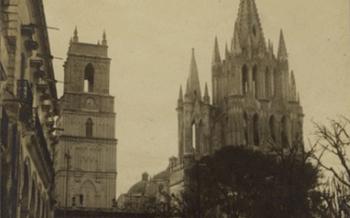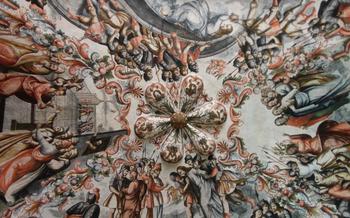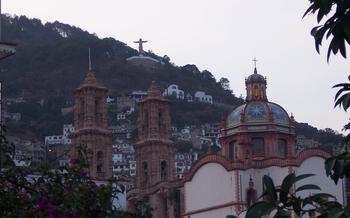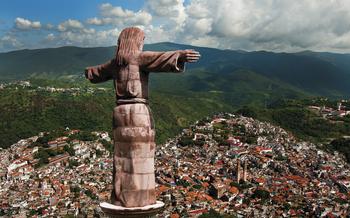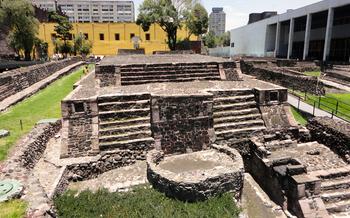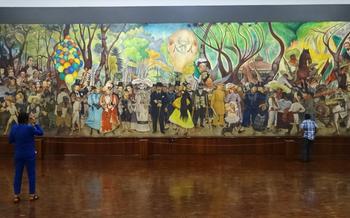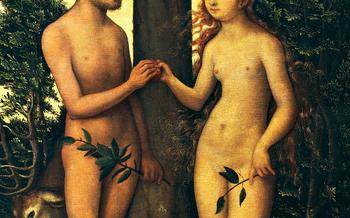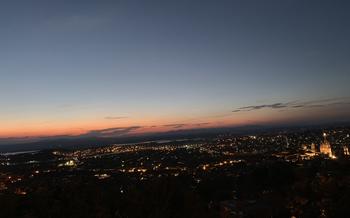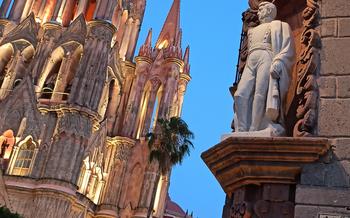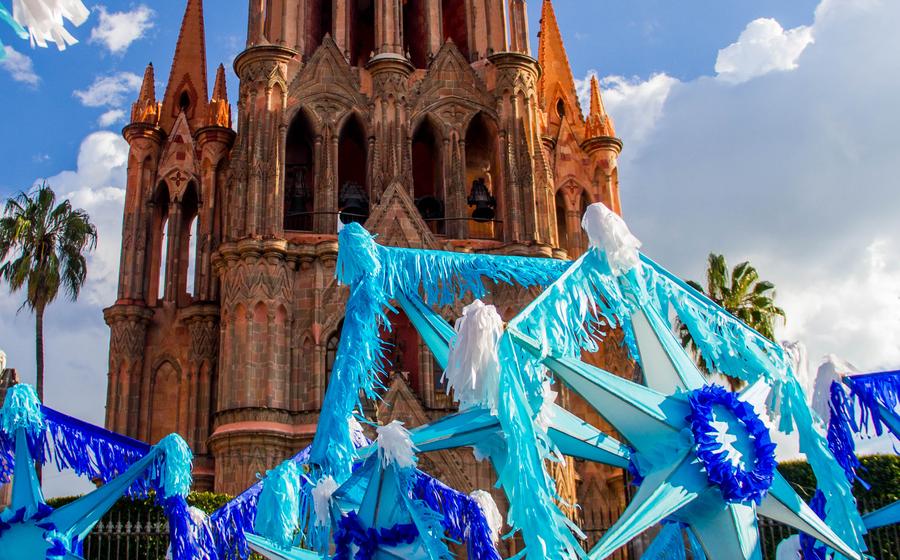
La Alborada
- The La Alborada in a Nutshell
- The Building and Architecture
- The Murals
- The Gardens
- The Cultural Significance
- The Artistic Significance
- The Historical Significance
- The Social Significance
- The Tourist Draw
- The Local's Perspective
- The Best Time to Visit
- What to Wear
- What to Bring
- What to Expect
- Insider Tip:
The La Alborada in a Nutshell
In the heart of San Miguel de Allende, where history and beauty intertwine, lies the La Alborada. This iconic venue, a testament to Mexican artistry and architectural prowess, was once the private residence of William Spratling, an American artist and silver craftsman. Built in the 1930s, La Alborada seamlessly blends colonial-era charm with modernistic design, standing as a testament to Spratling's love for Mexican culture and his vision of creating a vibrant artistic community.
Located at Hernández Macías 75, Centro, San Miguel de Allende, Guanajuato, Mexico, La Alborada welcomes visitors daily from 9 am to 5 pm. The entrance fee is 100 pesos for adults and 50 pesos for children and students. For those seeking a deeper immersion into the venue's history and artistic significance, guided tours are available for an additional fee.
The Building and Architecture
The La Alborada was designed by the renowned Mexican architect Luis Barragán, who is considered one of the most influential architects of the 20th century. Barragán's work is characterized by its use of simple forms, natural materials, and vibrant colors, and the La Alborada is no exception. The building's façade is a striking combination of pink and white walls, with large windows that let in plenty of natural light. The interior of the building is equally impressive, with its high ceilings, spacious rooms, and elegant furnishings. One of the most striking features of the La Alborada is its use of color. Barragán was a master of color, and he used it to create a sense of harmony and balance throughout the building. The pink and white walls of the façade are complemented by the green of the gardens, and the blue of the sky. The result is a building that is both visually stunning and deeply calming.
The Murals
The murals at La Alborada were created by David Alfaro Siqueiros, one of Mexico's most celebrated and controversial muralists. Born in Chihuahua in 1896, Siqueiros was a passionate advocate for social justice and a founding member of the Mexican Communist Party. His murals often depicted scenes of revolution, workers' struggles, and the plight of the poor.
At La Alborada, Siqueiros created a series of murals that explored the history and culture of Mexico. One of the most famous murals, titled "The Genesis of the New World," depicts the creation of the world according to Aztec mythology. Another mural, titled "The Conquest," portrays the arrival of the Spanish conquistadors and the fall of the Aztec Empire.
Siqueiros used a variety of techniques to create his murals, including fresco, tempera, and oil. He was also known for his use of bold colors and dynamic compositions. The murals at La Alborada are considered to be some of the finest examples of his work and are a must-see for any visitor to San Miguel de Allende.
The Gardens
The gardens at La Alborada are a true work of art, designed to complement and enhance the beauty of the building and murals. Lush and vibrant, they feature a wide variety of plants and flowers from all over the world, creating a diverse and captivating landscape. Visitors can stroll along winding paths, surrounded by colorful blooms, fragrant flowers, and the gentle sound of trickling water from the fountains. The gardens are a haven of tranquility and beauty, offering a respite from the hustle and bustle of the city. They provide a serene and picturesque setting for contemplation, relaxation, and artistic inspiration.
The Cultural Significance
The La Alborada is widely regarded as a cultural landmark, not just in San Miguel de Allende, but throughout Mexico. Its unique blend of architecture, art, and history has made it a symbol of Mexican culture and identity. The murals by David Alfaro Siqueiros, in particular, have been hailed as masterpieces of Mexican muralism and have had a profound influence on the development of Mexican art.
The venue has also played a significant role in promoting Mexican culture and tourism. It has hosted numerous cultural events, exhibitions, and performances, showcasing the work of local and international artists. These events have helped to raise the profile of San Miguel de Allende as a cultural destination and have attracted visitors from all over the world.
In addition, the La Alborada has been used as a backdrop for numerous films, television shows, and commercials. This exposure has further contributed to the venue's status as a cultural icon and has helped to spread Mexican culture to a wider audience.
Overall, the La Alborada is a vibrant and dynamic cultural space that plays a vital role in preserving and promoting Mexican culture. It is a must-visit destination for anyone interested in learning more about Mexico's rich history and artistic traditions.
The Artistic Significance
The La Alborada is widely regarded as an extraordinary work of art, thanks to the harmonious interplay of its architecture, murals, and gardens. It represents a unique fusion of artistic styles and techniques, resulting in a cohesive and visually stunning masterpiece. The building's striking façade is adorned with intricate stone carvings, decorative tiles, and wrought-iron balconies, showcasing the architect's attention to detail and artistic flair. Inside, the vibrant murals by David Alfaro Siqueiros, featuring bold colors and dynamic compositions, captivate visitors with their powerful narratives and artistic virtuosity.
The gardens, designed with meticulous care, serve as a canvas for a diverse array of plants and flowers, creating a vibrant and serene backdrop for the architectural and artistic elements. The harmonious interplay of these components gives rise to a multisensory experience, where visitors can immerse themselves in the beauty of art, nature, and history. La Alborada stands as a testament to the artistic genius of its creators and remains a source of inspiration for artists and art enthusiasts worldwide.
The Historical Significance
The La Alborada was built in 1950 by American artist and architect Stirling Dickinson. Dickinson was inspired by the beauty of San Miguel de Allende and wanted to create a space that would reflect the city's rich culture and history. The building was originally conceived as a private residence, but Dickinson later decided to open it to the public as a cultural center. Over the years, the La Alborada has hosted numerous exhibitions, concerts, and other events, and has become an important gathering place for artists and intellectuals in San Miguel de Allende.
The La Alborada is also significant for its association with the Mexican muralist David Alfaro Siqueiros. Siqueiros was commissioned by Dickinson to create a series of murals for the building, which were completed in 195These murals are considered to be some of Siqueiros's most important works, and they have been praised for their beauty, their political message, and their innovative use of technique.
The La Alborada has undergone several renovations over the years, but it has retained its original charm and character. Today, the building is a museum that is open to the public, and it is one of the most popular tourist attractions in San Miguel de Allende.
The Social Significance
The La Alborada is not just a work of art, but also a place where people of all walks of life have gathered throughout history. It has been used as a meeting place for artists, intellectuals, and political figures, who have come together to share ideas and create new works of art. It was at La Alborada that the Mexican muralist David Alfaro Siqueiros first met the American artist Jackson Pollock, leading to a collaboration that would change the course of modern art.
In addition to its role as a gathering place for artists, the La Alborada has also been used for social and political events. In the 1960s, it was a center of the student movement in Mexico, and it has also been used for protests and demonstrations. In recent years, it has been used for cultural events such as concerts, exhibitions, and film screenings.
The La Alborada's social significance is undeniable. It is a place where people from all walks of life have come together to share ideas, create art, and make history. It is a place where the past, present, and future of Mexican culture intersect, and it continues to be a vital part of the local community.
The Tourist Draw
The La Alborada draws tourists from all over the world with its unique blend of art, history, and culture. Visitors can expect to be amazed by the stunning architecture, the beautiful murals, and the lush gardens. There are also a number of special events and activities that are held at the venue throughout the year, such as art exhibitions, concerts, and workshops.
One of the most popular things to do at the La Alborada is to simply wander around the gardens and admire the beautiful flowers and plants. Visitors can also take a guided tour of the venue, which provides a more in-depth look at the history, architecture, and murals.
The La Alborada is a must-see for any visitor to San Miguel de Allende. It is a place where visitors can learn about Mexican history and culture, appreciate the beauty of art, and simply relax and enjoy the tranquility of the gardens.
The Local's Perspective
Locals take great pride in the La Alborada, considering it a symbol of their city's rich cultural heritage. They often gather at the venue for social events, celebrations, and community meetings. The gardens are a popular spot for locals to relax and enjoy the outdoors, while the murals and architecture are a source of inspiration and pride. The La Alborada also hosts various cultural events throughout the year, such as art exhibitions, concerts, and dance performances, which are popular with locals and tourists alike. For locals, the La Alborada is more than just a cultural landmark; it is a beloved gathering place and a symbol of their community's identity and spirit.
The Best Time to Visit
The best time to visit the La Alborada is during the dry season, which runs from November to April. During this time, the weather is warm and sunny, with little to no rain. This makes it ideal for exploring the gardens and taking photos. Additionally, the venue is less crowded during this time, so visitors can enjoy a more relaxed and intimate experience.
There are also several special events and activities that are held at the La Alborada throughout the year. These include art exhibitions, concerts, and dance performances. Visitors can check the venue's website or social media pages for a full list of upcoming events.
The gardens at the La Alborada are at their most beautiful in the spring, when the flowers are in full bloom. This is a great time to visit for those who want to see the venue at its most vibrant and colorful.
However, it is important to note that the La Alborada is a popular tourist destination, so it can get crowded, especially during the peak season from December to February. If you are looking for a more peaceful and secluded experience, it is best to avoid visiting during this time.
What to Wear
The La Alborada does not have a strict dress code, but visitors should dress respectfully, as it is a cultural and historical landmark. Comfortable clothing and shoes are recommended, as there is a lot of walking involved in exploring the gardens and the building.
For the weather in San Miguel de Allende, light, airy clothing is best, as the weather is warm and sunny year-round. A hat and sunglasses are also recommended to protect from the sun.
When taking photos, it is important to be mindful of the lighting and the background. The gardens are especially beautiful in the morning and evening light, and the building's façade is best photographed in the late afternoon.
If you are planning to purchase souvenirs or mementos, there is a small gift shop on the premises. You can find a variety of items, including books, prints, and pottery.
What to Bring
When visiting La Alborada, there are a few essentials that visitors should bring with them. First and foremost, comfortable shoes are a must, as there is a fair bit of walking involved in exploring the gardens and the interior of the building. A camera is also a good idea, as the venue is full of beautiful photo opportunities. Visitors may also want to bring a notebook and pen to jot down any thoughts or observations they have about the murals or the architecture.
In terms of snacks and drinks, visitors are welcome to bring their own, but there is also a small café on-site where they can purchase refreshments. As for souvenirs, there is a gift shop at the venue where visitors can purchase a variety of items, including postcards, books, and reproductions of the murals.
What to Expect
When visiting La Alborada, visitors can expect to be immersed in a world of art, history, and culture. They can admire the stunning murals that adorn the walls of the building, depicting scenes from Mexican history and mythology. They can stroll through the lush gardens, filled with colorful flowers and exotic plants, and take in the beauty of the natural surroundings. Visitors can also learn about the history of the venue and its cultural significance through guided tours or informational panels.
La Alborada often hosts special events and activities, such as art exhibitions, concerts, and workshops. These events provide visitors with an opportunity to experience the venue's vibrant cultural scene and engage with local artists and performers. It is recommended to check the venue's website or social media pages for upcoming events and activities.
Visitors should plan to spend at least an hour or two exploring La Alborada. The venue is relatively small, but its rich history and artistic significance make it a worthwhile destination. However, visitors who are particularly interested in art or history may want to allow more time to fully appreciate the venue's many offerings.
One potential challenge that visitors may encounter is the weather. San Miguel de Allende has a semi-arid climate, with hot, dry summers and mild, dry winters. Visitors should be prepared for warm temperatures, especially during the summer months. It is advisable to wear comfortable clothing and sunscreen, and to bring a hat or umbrella for shade.
Insider Tip:
-
To fully appreciate the beauty of the La Alborada, visit during the golden hour, just before sunset, when the light casts a warm glow on the building and gardens, creating a magical atmosphere.
-
If you're interested in learning more about the history and significance of the La Alborada, consider booking a guided tour. Tours are available in English and Spanish and provide a wealth of information about the venue's architecture, murals, and cultural importance.
-
For a truly unique experience, plan your visit to coincide with one of the many events and activities that are held at the La Alborada throughout the year. These events include art exhibitions, concerts, and cultural festivals, offering a chance to immerse yourself in the vibrant arts scene of San Miguel de Allende.
-
When visiting the La Alborada, be sure to take your time and soak in the atmosphere. Find a quiet spot in the gardens to relax and reflect, or enjoy a leisurely stroll through the building's interior, admiring the intricate murals and architectural details.
